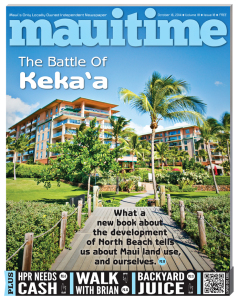
The Battle Of Kekaa: What Sydney Lehua Iaukea's new book on the development of North Beach says about Maui land use, and ourselves
Maui Time
October 16, 2010
BY ANTHONY PIGNATARO

It's hard to believe that just a decade ago, the Westside beaches that stretched from the Royal Lahaina Resort to Honokowai were largely empty. There were just grassy fields between the highway and the water. Known as Keka'a or, more colloquially, North Beach, this was the capital of Maui. Kaka'alaneo ruled there 500 years ago, and it was home to about 3,000 Hawaiians.
That's all in the past now–including the grassy fields. Go to Keka'a today and you'll see transplanted palm trees, boardwalks, swimming pools, massive timeshares and tourists–hundreds, if not thousands, of tourists. The Westin Ka'anapali Ocean Resort Villas are there, as is the Honua Kai Resort & Spa.
Back in 2006, the development of Keka'a was big news around Maui. In the year or so before the housing market collapsed, it seemed like all of West Maui would fall beneath bulldozers, and the big "timeshare resorts" planned for Keka'a were just the first step. While much of the later development still has yet to happen (like Maui Land & Pineapple Company's big Pulelehua project), North Beach did end up changing from largely untouched beachfront into an extension of the greater Ka'anapali resort.
It was a beach where residents could camp, fly kites or even throw raging parties because it was big and far from places where people lived, though it was still very much still part of West Maui. Its development over the last couple decades has been anything but easy.
"I want to save North beach because that is my favorite beach," Rochells Bucaneg of Princess Nahi'ena'ena Elementary School wrote in a letter to the Maui Planning Commission in the 1990s. "People can go swimming, fishing, snorkal [sic] and driving and the kids can play in the sand and have fun. People can lay down under the coconut trees and rest."
The development of North Beach was a real fight–more so in some ways than larger Ka'anapali to the south. The story of that development–told from the perspective of those who fought it and, to at least some extent, succeeded in scaling it back–is now available in a new book by Sydney Lehua Iaukea, PhD. Commissioned by the North Beach-West Maui Benefit Fund–which is in itself a result of that fight–the book has a radical take on both the battles over Keka'a and the island's tourism economy in general.
A doctor of political science who currently lectures at Windward Community College and the University of Hawaii's Manoa campus, Iaukea grew up on Maui. In fact, her earliest jobs helped her understand how the island's tourism economy affects both the landscape and the residents who work in it. Like many young people on the island, she went to work at the big Ka'anapali resorts. And like many of her contemporaries, she quickly found that her job required her to be subservient to transient visitors. In fact, while working as a hostess and cocktail server at the Sheraton, Iaukea even found herself required to take "How to be Aloha" classes.
"I was deeply disturbed by these experiences, but not able to adequately formalize or articulate the problem," she writes. "It would be many years before I could put into words the discomfort I felt for being treated like a servant, and told to do so with a smile on my face and aloha in my heart. I have been critical of the tourism industry ever since."
This notion of local subservience before tourists runs throughout the book, which draws a large array of environmental impact reports, old Pioneer Mill records and news accounts (including a couple MauiTime articles). There is no way the development at Keka'a and elsewhere could have taken place without it.
"I had just graduated from Kamehemeha Schools," Iaukea told me in a phone interview. "I had a different idea of what the culture is–it's not just to greet the tourists."

Sydney Lehua Iaukea
But as she shows in sometimes bitter detail, Iaukea's idea is definitely a minority position. Her thesis is radical: when American Factors, which reshaped West Maui's land and water for the purpose of growing sugar, began to fall apart financially, it merely grafted a new narrative–the need to cater to tourists–on its old sugar infrastructure. The result was Ka'anapali, which immediately proved profitable but mostly stopped at Black Rock. Later, others would come in and extend Ka'anapali into North Beach.
This was possible, at least in part legally, because of numerous archaeological studies–and the 1996 Special Management Area Use Permit–that found "no evidence" of historical importance at Keka'a. There were no heiau features or pre-historic trails. Nor could they find any "mythological evidence that the project site has any significance," as the SMA permit concluded.
"Like some perverse development mantra, 'no evidence and no significance' was drummed into the documents and through its inclusion reinforced that idea that the land is disconnected from the surrounding environment," Iaukea writes. "Here the landscape was systematically flattened of significance so that a re-imagination of the space could occur–one that ignored larger land narratives."
Of course, this was all made possible by the fact that the previous sugar plantation had largely wiped the land clean of evidence of previous, pre-contact Hawaiian life. Though Iaukea quotes from a 2001 Lahaina archaeological survey noting that "it is likely that the early historic agricultural clearing destroyed all of the large platform or heiau sites which may once have existed," she also bitterly notes that "What is destroyed cannot be recovered."
Maybe not, but it could be developed. As Iaukea notes, the transition from sugar production to resort development was remarkably simple.
"Following closely behind sugar production, the hotel developers did not need to invent a new social narrative of this land, but simply build on the narrative of theft already enacted by the sugar growers–one that viewed the 'aina as empty space," Iaukea writes.
But it was the residents who provided what Iaukea calls the "submissive community support" that provide most of the legitimacy that backstops today's big North Beach timeshares. In short, the political establishment will always make it easier to support the continuation and expansion of the tourism economy than oppose it.
"Getting off the plantation is easier to imagine than accomplish, because it takes a paradigm shift regarding the purpose of the land and people and industry," Iaukea writes. "For many years, local history and livelihoods have reflected the economic rhetoric of two industries–sugar and tourism–and tourism still has a stranglehold on government and individual perceptions of growth and opportunity."
Why does it have to be this way?
"I think it starts with the education system," Iaukea told me. "The Department of Education has always supported the [tourism] industry through their curriculum, which provides labor instead of critical thinking. Everything has been set up to support whatever industry is using the land."
Which is why many of the problems associated with development (what economists call "negative externalities") often get lost or ignored entirely.
"Some of the results associated with resort development are poor infrastructure planning, rising land costs that attract outside investors and therefore preempt locals from buying property, the marginalization and destruction of native habitats and people, and the presentation of such development as natural, and supposedly caring for the land and people on which it encroaches," Iaukea writes. "But economic profit does not care about caring. On Maui, sugar and hotels dominate the socio-economic strata and the panoramic landscape–naturalizing their presence by their very existence."
Add to that the natural tendency around here to build big hotels and timeshares before infrastructure improvements like the Lahaina Bypass Highway get finished–though it partially exists now, that highway was planned to go to Honokowai–and things can get ugly really fast. But those things are contrary to the Big Message: Hotels, resorts and timeshares are good for Maui. They respect Maui and care for Maui.
We can see this attitude in the marketing materials of the timeshares that dominate North Beach today. "Honua Kai Resort & Spa warmly welcomes each guest to our Kaanapali Beach Resort to experience an entirely new hospitality experience on Maui where we respectfully bring the essence of Hawaiian values into our contemporary resort with a vision based on sustainability, renewability and inspiration," states the Honua Kai's "Promise, Vision & Principles" webpage.
This is all part of what Iaukea refers to as "the tourist gaze," which she takes from the title of sociologist John Urry's 2002 book, which analyzed the underpinnings of the tourist economy. It's her way of describing the very unnatural ways in which natural Maui gets remade for tourists.
"Urry discusses how both nature and native are neutralized, and then systematically reimagined, within the constructs of the tourist economy," Iaukea writes. "In other words, land/native first have to be made visible and visitable in order to be gazed upon. And this endeavor takes some manipulation of the natural. The visitor economy provides the frame whereby places/people are first imagined and then visited–as the entire point is to come, see, have the experience, and leave. Within this agenda, superficial understandings are formed and reinforced."
Still, this is not an entirely depressing book, which in many ways is the "official" story of the West Maui Preservation Association (WMPA), a small group of intervenors who challenged big North Beach developers like Intrawest a decade ago and won various public interest concessions (scaled back development, beach boardwalks, traffic mitigation funds and so forth), as well as the "Save North Beach" activists throughout the 1990s like the student I quoted above. While we may think those concessions are small when compared to what North Beach used to be just a decade ago, we also have to acknowledge that the development of Keka'a could have been a lot worse.
"Keka'a is one of the pivotal places in Hawaii," Iaukea told me. "And I know that among the first intervenors I interviewed, there is still a lot of emotion."
* * *
Book Launch
On Saturday, Nov. 1 at noon, Sydney Lehua Iaukea will appear at the Lahaina Public Library to launch her new book Keka'a: The Making And Saving of North Beach West Maui. Books will be available for sale. The price is $20. Book distribution is by UH Press, and it should soon be available at Barnes & Noble in Lahaina.
Cover photo: Sean M. Hower
Author photo courtesy Sydney Iaukea
North Beach West Maui Benefit Fund, Inc.
P O BOX 11329
LAHAINA, Hawaii 96761